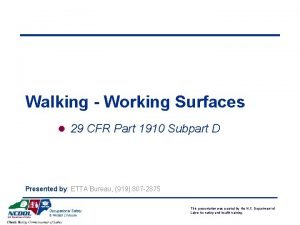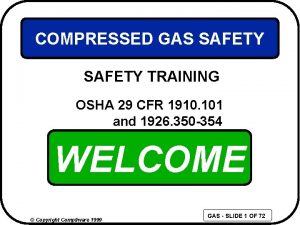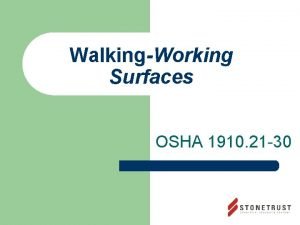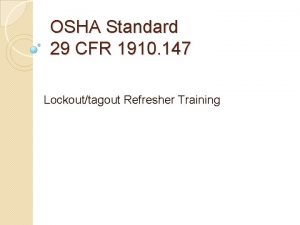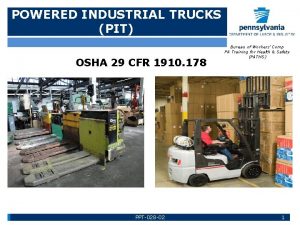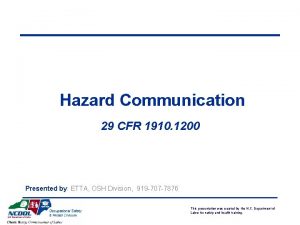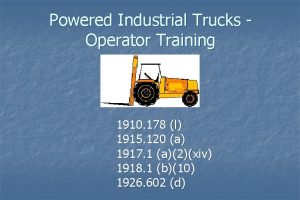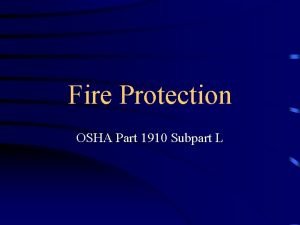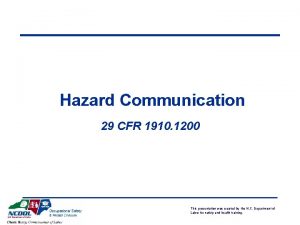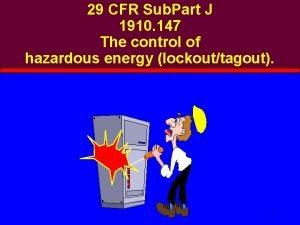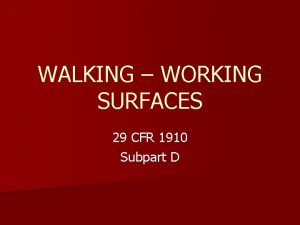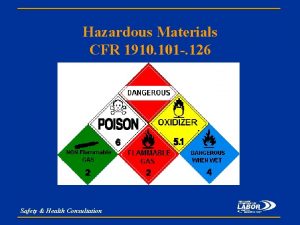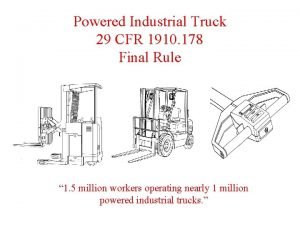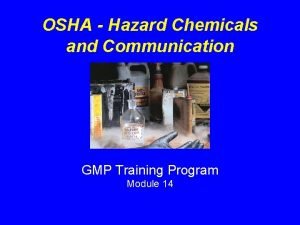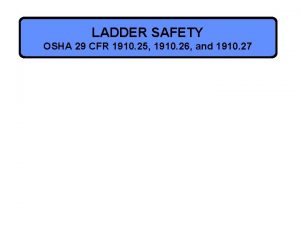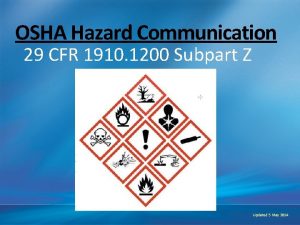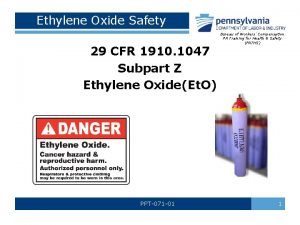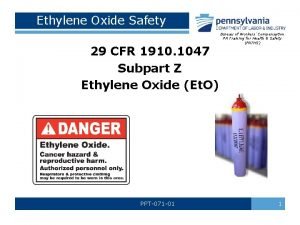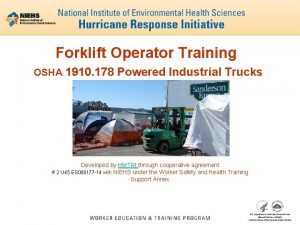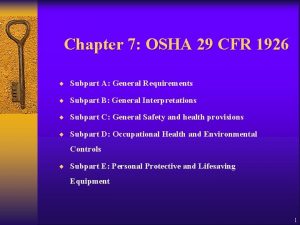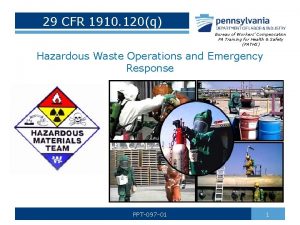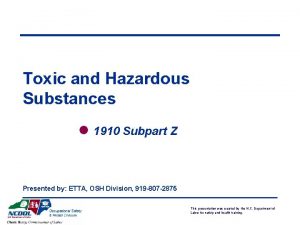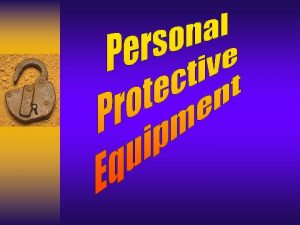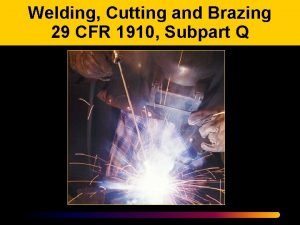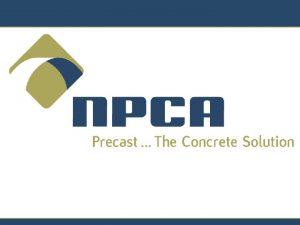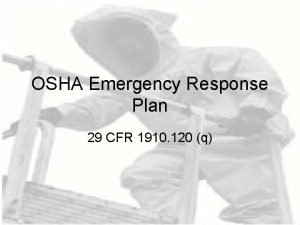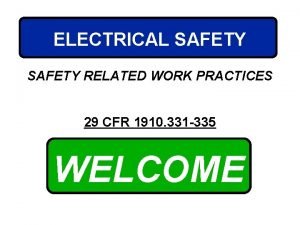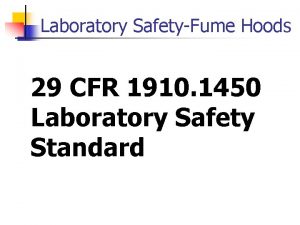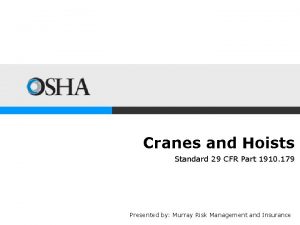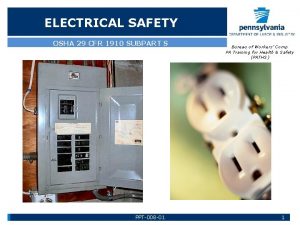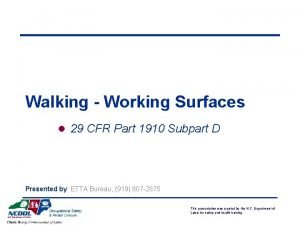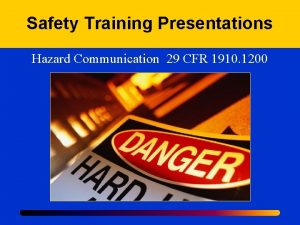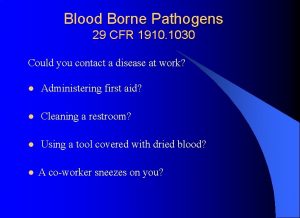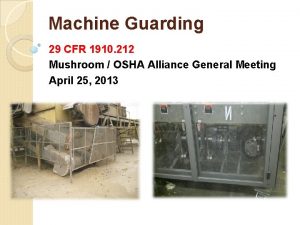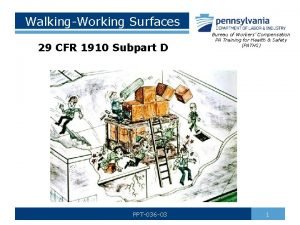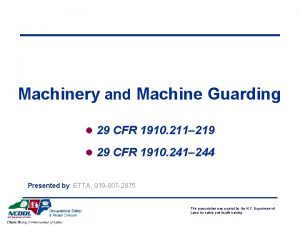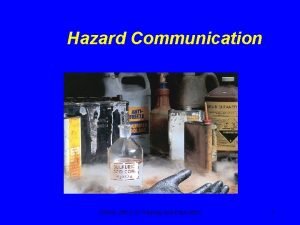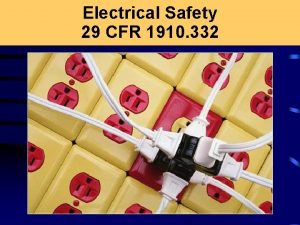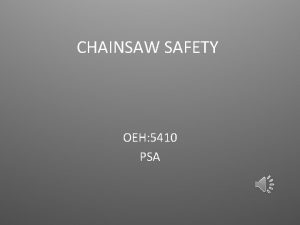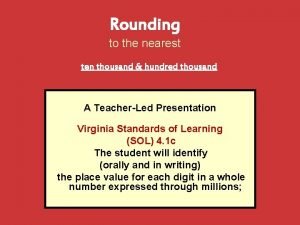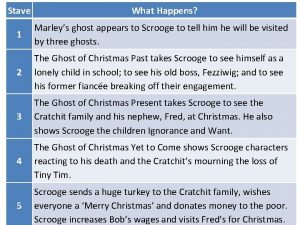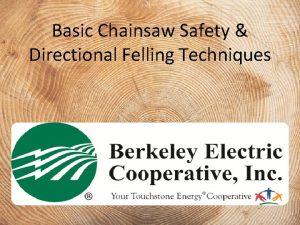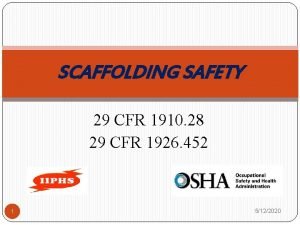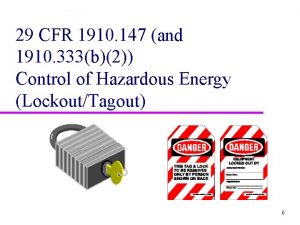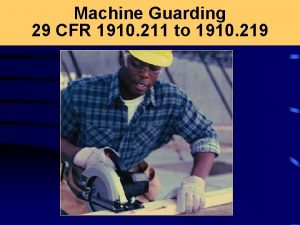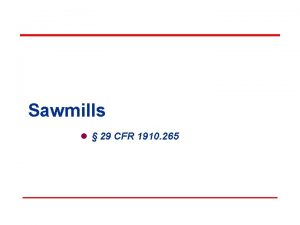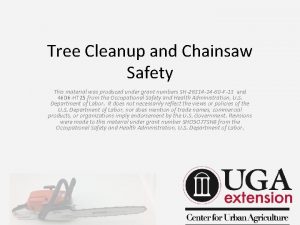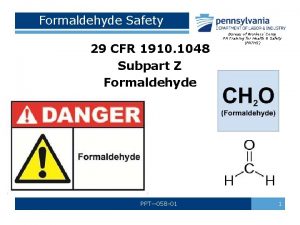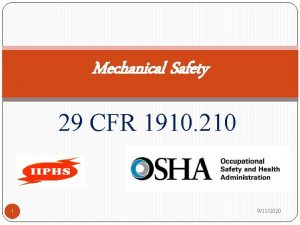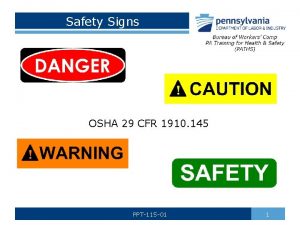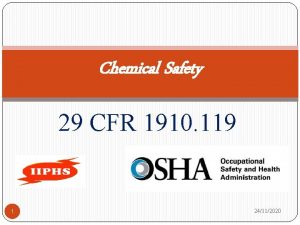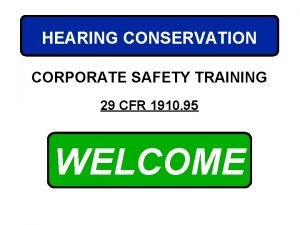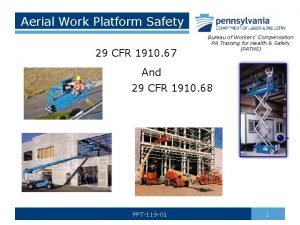Chainsaw Safety l 29 CFR 1910 266 Presented






















































- Slides: 54

Chainsaw Safety l 29 CFR 1910. 266 Presented by: This presentation was created by the N. C. Department of Labor for safety and health training.

Objectives 29 CFR 1910. 266 l At the end of this course, students will: - Understand relevant definitions - Know appropriate PPE for chainsaw activities - Be able to recognize basic chainsaw hazards - Understand the basics of chainsaw safety - Understand training requirements This presentation was created by the N. C. Department of Labor for safety and health training.

Definitions 1910. 266(c) l Backcut (felling cut) - Final cut in a felling operation. l Bucking - Sawing felled trees into sections called logs. l Danger tree - Standing tree that presents a hazard to employees due to deterioration or physical damage to the root system, trunk, stem or limbs, and the direction and lean of the tree. This presentation was created by the N. C. Department of Labor for safety and health training.

Definitions 1910. 266(c) l Limbing - To cut branches off felled trees. l Logging operations - Operations associated with felling and moving trees and logs from the stump to the point of delivery. l Spring pole - A tree, segment of a tree, limb, or sapling under stress or tension due to pressure or weight of another object. This presentation was created by the N. C. Department of Labor for safety and health training.

Definitions 1910. 266(c) l Undercut - A notch cut in a tree to guide the direction of the tree fall and to prevent splitting or kickback. l Yarding - Movement of logs from the place they are felled to a landing. This presentation was created by the N. C. Department of Labor for safety and health training.

Felling Trees l More people are killed while felling trees than during any other logging activity. “Barber chair” This presentation was created by the N. C. Department of Labor for safety and health training.

Chainsaw Operator Injuries This presentation was created by the N. C. Department of Labor for safety and health training.

Personal Protective Equipment 1910. 266(d)(1) l PPE must be inspected prior to use on each workshift to ensure it is in serviceable condition. l PPE must be used when hazards make it necessary. - Except for foot protection, all PPE must be provided by the employer at no cost to the employee. This presentation was created by the N. C. Department of Labor for safety and health training.

Personal Equipment Checklist l Hand protection if handling wire rope l Leg protection l Foot protection l Head protection l Eye and face protection l Hearing protection l First aid kits This presentation was created by the N. C. Department of Labor for safety and health training.

Hand Protection 1910. 266(d)(1)(iii) l Employees who handle wire rope are required to wear hand protection that protects against puncture wounds, cuts, and lacerations. This presentation was created by the N. C. Department of Labor for safety and health training.

Leg Protection 1910. 266(d)(1)(iv) l Each employee who operates a chainsaw must wear leg protection constructed with cutresistant material. This presentation was created by the N. C. Department of Labor for safety and health training.

Leg Protection 1910. 266(d)(1)(iv) This presentation was created by the N. C. Department of Labor for safety and health training.

Foot Protection 1910. 266(d)(1)(v) l Foot protection that is constructed with cut- resistant material. This presentation was created by the N. C. Department of Labor for safety and health training.

Head Protection 1910. 266(d)(1)(vi) l Hard hats must be worn when overhead hazards are present. This presentation was created by the N. C. Department of Labor for safety and health training.

Eye and Face Protection 1910. 266(d)(1)(vii) l Eye and face protection must be worn where there is potential for injury to the eyes or face. This presentation was created by the N. C. Department of Labor for safety and health training.

Hearing Protection 1910. 95 l When employees are exposed to sound exceeding levels in Table G-16 (below), feasible administrative or engineering controls shall be utilized. – If controls fail to reduce sound levels, hearing protections shall be provided. Duration (hours per day) d. BA 8 90 6 92 4 95 3 97 2 100 1½ 102 1 105 ½ 110 ¼ or less 115 This presentation was created by the N. C. Department of Labor for safety and health training.

Good, but could it be better? This presentation was created by the N. C. Department of Labor for safety and health training.

First Aid Kits 1910. 266(d)(2) l Provided at each work site where trees are being cut. l Number and contents of each kit shall reflect the degree of isolation, number of employees, and hazards reasonably anticipated at work site. - Appendix A - Maintained in serviceable condition This presentation was created by the N. C. Department of Labor for safety and health training.

Signaling and Signal Equipment 1910. 266(d)(7) l Hand signals or audible contact utilized whenever factors prevent clear understanding of voice communications between employees. l Only a designated person gives signals, except in an emergency. This presentation was created by the N. C. Department of Labor for safety and health training.

Flammable and Combustible Liquids 1910. 266(d)(9) l Flammable and combustible liquids shall be stored, handled, transported, and used in accordance with the requirements of 1910. 106. l Flammable and combustible liquids shall not be transported in the driver compartment or in any passenger-occupied area of a machine or vehicle. This presentation was created by the N. C. Department of Labor for safety and health training.

Chainsaw Checklist 1910. 266(e)(1)-(2) – Chain brake – Throttle interlock – Chain catcher – Chain tension – Muffler – Chainsaw kickback – Chain sharpness, cutter shape, depth usage setting, lubrication – Handles and guards on tight – No chain movement when engine is idling This presentation was created by the N. C. Department of Labor for safety and health training.

Chainsaw Mechanisms 1910. 266(e)(2) 1. Chain catcher – prevents a broken or dislodged chain from striking the logger 2. Flywheel 3. Clutch 4. Decompression valve 5. /7. Anti-vibration handle system – recommended by OSHA to limit ergonomic stress to logger’s joints This presentation was created by the N. C. Department of Labor for safety and health training.

Chainsaw Mechanisms 1910. 266(e)(2) 6. Hand guard 8. Muffler to reduce engine noise 9. Chain brake – stops chain if kickback occurs (if saw was placed into service after 2/9/95) 10. Throttle – will stop chain when pressure on throttle is released 11. Throttle interlock – prevents throttle from activating until interlock is depressed This presentation was created by the N. C. Department of Labor for safety and health training.

Before Starting the Saw 1910. 266(e)(2) l Chainsaw fueled at least 10 feet from sources of ignition. l Fuel container should meet the following requirements identified in 1910. 266(d)(9): - Must be metal or plastic. - Must not exceed a 5 -gallon capacity. - Must be approved by the Underwriters Laboratory (UL), Factory Mutual (FM), the Department of Transportation (DOT), or other Nationally Recognized Testing Laboratory (NRTL). This presentation was created by the N. C. Department of Labor for safety and health training.

Before Starting the Saw 1910. 266(e)(2) l Controls, chain tension, and all bolts and handles checked to ensure they are functioning properly and adjusted according to the manufacturer's instructions. l Chainsaw started at least 10 feet from fueling area, with chain brake engaged, and with chainsaw on the ground or otherwise firmly supported. This presentation was created by the N. C. Department of Labor for safety and health training.

While Running the Saw 1910. 266(e)(2) l Both hands on the handles l Secure footing maintained l Obstacles cleared that interfere with cutting the tree or retreating l Chainsaw should not be used above shoulder level This presentation was created by the N. C. Department of Labor for safety and health training.

While Running the Saw 1910. 266(e)(2) l Throttle released, chain brake on prior to retreating l Chainsaw is off or chain brake engaged whenever it’s carried more than two steps or on hazardous terrain This presentation was created by the N. C. Department of Labor for safety and health training.

Manual Felling 1910. 266(h)(2) l Potential hazards eliminated or minimized l Felling direction determined l Retreat path planned and cleared l Hinge size determined l Proper felling techniques used This presentation was created by the N. C. Department of Labor for safety and health training.

Eliminate/Minimize Hazards 1910. 266(h)(2) l Primary hazards include unstable logs and hazards associated with using chainsaws. l Prior to limbing, the following is evaluated: - Overhead hazards - Butt movement forward - Butt twist - Butt off the ground - “Danger trees” This presentation was created by the N. C. Department of Labor for safety and health training.

Limbing and Bucking 1910. 266(h)(3) l Limbing and bucking shall be done on the uphill side of each tree or log on any slope where rolling or sliding of trees or logs is reasonably foreseeable. l Loggers should never limb a tree immediately after felling. l Good idea to drop several trees and then refuel the saw prior to limbing. – Provides time for overhead hazards to come down. This presentation was created by the N. C. Department of Labor for safety and health training.

“Danger Trees" 1910. 266(h) l Lodged trees l Entangled trees “Lodged Trees” This presentation was created by the N. C. Department of Labor for safety and health training.

“Danger Trees" 1910. 266(h) l Spring poles l Dead trees/limbs l Stalled trees This presentation was created by the N. C. Department of Labor for safety and health training.

“Dutchman Cut" This presentation was created by the N. C. Department of Labor for safety and health training.

Felling Direction 1910. 266(h)(2) l Clear fall path - A clear fall path is an important factor in deciding what direction to fell a tree. - Fall path should be visualized in all directions and identify those directions that are free of other trees. - Finding a clear path will eliminate lodged trees, throwback, and damage to the tree being felled as well as the other trees. This presentation was created by the N. C. Department of Labor for safety and health training.

Felling Direction 1910. 266(h)(2) l Clear landing - Felling a tree onto stumps, large rocks, or uneven ground should be avoided. » This will prevent or reduce cracking and other damage to the tree, and limit the potential for rebound of the tree. l Lean of tree - Generally easier and safer to fell a tree in direction that it is already leaning. » This makes for a cleaner fall and eliminates the need to use wedges, allowing gravity to do the work. This presentation was created by the N. C. Department of Labor for safety and health training.

Felling Direction 1910. 266(h)(2) l Ease of removal - When possible, the butt of felled tree should face the skid road, and tree consistent with felling pattern of other trees. » Makes for efficient limbing and removal. l Slope of ground - Fell in direction that will minimize chance the tree will roll/slide. This presentation was created by the N. C. Department of Labor for safety and health training.

Felling Direction 1910. 266(h)(2) This presentation was created by the N. C. Department of Labor for safety and health training.

Retreat Path 1910. 266(h)(2)(i) l Before felling is started, the feller shall plan and clear a retreat path. l Retreat path shall extend diagonally away from the expected felling line unless the employer demonstrates that such a retreat path poses a greater hazard than an alternate path. l Once the backcut has been made the feller shall immediately move a safe distance away from the tree on the retreat path. This presentation was created by the N. C. Department of Labor for safety and health training.

Retreat Path 1910. 266(h)(2)(i) This presentation was created by the N. C. Department of Labor for safety and health training.

Hinge Size 1910. 266(h)(2)(vi) l Hinge length should be 80% of the diameter of the tree at breast height. l Hinge width should be 10% of the diameter of the tree at breast height. l Hinge on a tree with no side lean should be perpendicular to the intended direction of fall. This presentation was created by the N. C. Department of Labor for safety and health training.

Felling Techniques 1910. 266(h)(2)(v)-(vii) l Backcut - Shall be made in each tree being felled. - Shall leave sufficient hinge wood to hold tree to stump during most of its fall so hinge is able to guide the tree's fall in intended direction. - Shall be above level of horizontal facecut in order to provide an adequate platform to prevent kickback. » Exception: Backcut may be at or below horizontal facecut in tree pulling operations. » Requirement does not apply to open face felling where two angled facecuts rather than a horizontal facecut are used. This presentation was created by the N. C. Department of Labor for safety and health training.

Felling Techniques 1910. 266(h)(2)(v)-(vii) l Undercut - Shall be made in each tree being felled unless the employer demonstrates that felling the tree without an undercut will not create a hazard for an employee. - Shall be of a size so the tree will not split and will fall in the intended direction. This presentation was created by the N. C. Department of Labor for safety and health training.

Type of Cuts This presentation was created by the N. C. Department of Labor for safety and health training.

Types of Notches This presentation was created by the N. C. Department of Labor for safety and health training.

Does this cut look correct? This presentation was created by the N. C. Department of Labor for safety and health training.

Does this cut look correct? This presentation was created by the N. C. Department of Labor for safety and health training.

Is he cutting correctly? This presentation was created by the N. C. Department of Labor for safety and health training.

Training 1910. 266(i)(2) l Frequency - Prior to initial assignment - Whenever assigned new tasks, tools, equipment, machines, or vehicles - Employee demonstrates unsafe job performance This presentation was created by the N. C. Department of Labor for safety and health training.

Training 1910. 266(i)(3) l Content - Safe performance of assigned work tasks - Recognition of safety and health hazards - Procedures, practices and requirements of the employer's work site - Requirements of this standard This presentation was created by the N. C. Department of Labor for safety and health training.

Training 1910. 266(i)(5) – (6) l Employer must ensure that each employee can properly and safely perform the work tasks and operate tools, equipment, machines, and vehicles used in their job. l Each employee shall work under the close supervision of a designated person until employee demonstrates the ability to safely perform their new duties independently. This presentation was created by the N. C. Department of Labor for safety and health training.

Training 1910. 266(i)(7) l First aid training - Employer shall assure each employee, including supervisors, receives or has received first aid and CPR training. - Employer shall assure each employee's first aid and CPR training and/or certificate of training remain current. This presentation was created by the N. C. Department of Labor for safety and health training.

Training 1910. 266(i)(8)-(10) l Training conducted by a designated person. l Training presented in a manner that employee is able to understand. l Written certification record This presentation was created by the N. C. Department of Labor for safety and health training.

Summary l In this course, we discussed: - Definitions - Personal protective equipment - Hazards - Chainsaw safety - Training This presentation was created by the N. C. Department of Labor for safety and health training.

Thank You For Attending! Final Questions? This presentation was created by the N. C. Department of Labor for safety and health training.
 29 cfr 1910.
29 cfr 1910. Every open sided floor or platform
Every open sided floor or platform 29 cfr 1910 compressed gas cylinder storage
29 cfr 1910 compressed gas cylinder storage Housekeeping osha 1910
Housekeeping osha 1910 29 cfr 1910
29 cfr 1910 Osha 1910 powered industrial trucks
Osha 1910 powered industrial trucks 29 cfr 1910 powered industrial trucks
29 cfr 1910 powered industrial trucks 29 cfr1910.1200
29 cfr1910.1200 29 cfr 1910 osha 178
29 cfr 1910 osha 178 29 cfr 1910 subpart i
29 cfr 1910 subpart i 29 cfr1910.1200
29 cfr1910.1200 29 cfr 1910
29 cfr 1910 D3ladder
D3ladder 29 cfr 1910 hazardous materials
29 cfr 1910 hazardous materials 29 cfr 1910 powered industrial trucks
29 cfr 1910 powered industrial trucks Osha hazard and ghs training regulation cfr 1910
Osha hazard and ghs training regulation cfr 1910 29 cfr 1910
29 cfr 1910 29 cfr 1910 section 1200
29 cfr 1910 section 1200 What is ethylene oxide
What is ethylene oxide 1910 ppe
1910 ppe 49 cfr 1910
49 cfr 1910 29 cfr 1910 powered industrial trucks
29 cfr 1910 powered industrial trucks Osha 1926 subpart c
Osha 1926 subpart c 29 cfr 1910 120
29 cfr 1910 120 29 cfr 1910 subpart z
29 cfr 1910 subpart z 29 cfr1910.1200
29 cfr1910.1200 29cfr1910.132
29cfr1910.132 29 cfr 1910 subpart q
29 cfr 1910 subpart q 29 cfr 1910 1200
29 cfr 1910 1200 Osha 1910 120
Osha 1910 120 29 cfr 1910
29 cfr 1910 29 cfr 1910 osha 178
29 cfr 1910 osha 178 Osha crane standard 1910
Osha crane standard 1910 Osha electrical safety standard 1910
Osha electrical safety standard 1910 Bloodborne pathogens standard 29 cfr 1910
Bloodborne pathogens standard 29 cfr 1910 Osha racking requirements 1910
Osha racking requirements 1910 29 cfr 1910
29 cfr 1910 29 cfr 1910 1030
29 cfr 1910 1030 29 cfr 1910
29 cfr 1910 Osha 1910 subpart d
Osha 1910 subpart d 29cfr1910
29cfr1910 Osha cfr 1910 is the standard for______.
Osha cfr 1910 is the standard for______. A person usually offers the most resistance to electricity
A person usually offers the most resistance to electricity Chainsaw vs the pampas grass
Chainsaw vs the pampas grass Chainsaw injury statistics
Chainsaw injury statistics E 266
E 266 Brinclhof
Brinclhof Round 625 to the nearest hundred
Round 625 to the nearest hundred 348 rounded to the nearest ten
348 rounded to the nearest ten Flex zel
Flex zel The kitchen presented by
The kitchen presented by How are the events in the text presented
How are the events in the text presented How is marley's ghost presented in stave 1
How is marley's ghost presented in stave 1 Romeo and juliet themes love
Romeo and juliet themes love How it's made presented by
How it's made presented by

